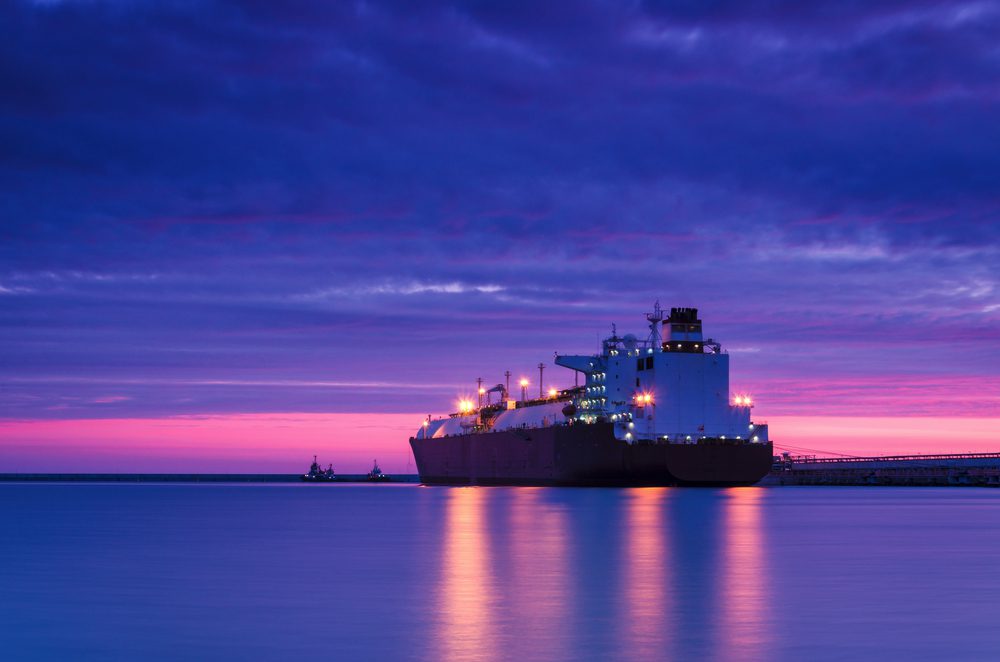Photo: Wojciech Wrzesien / Shutterstock
By Brian Parkin and Anna Shiryaevskaya (Bloomberg) — Downstream from Hamburg, two small Elbe River ports are competing to build Germany’s first liquefied natural gas import terminal and help shake up Europe’s biggest gas market.
Hugging opposite banks of the river before it arcs into the North Sea, Stade and Brunsbuettel are battling for federal approval and hundreds of millions of euros in investment. The government may announce a winner next year, ending dithering about the need for such a facility and pressure by President Donald Trump to import U.S. fuel to cut reliance on Russian gas.
Both sites tout their advantages but the main winner will be Germany, said Oliver Grundmann, Stade’s constituency lawmaker from Chancellor Angela Merkel’s Christian Democrats, on the phone Monday. Other sites are also being considered, such as the Baltic Sea port of Wilhelmshaven.
“The strategic relevance of diversifying our gas supplies via LNG is, I hope, by now a given,” Grundmann said. “The big question is who can build it fast and run it cost-effectively.”
Pressure by Trump on Germany this summer to dump its support for Russia’s Nord Stream 2 pipeline project in favor of U.S. shale gas in ships is a boon to ports jockeying to become a LNG hub. Federal aid is seen as critical to the project’s structured finance, enabling the winner to speed up construction.
Supplies of gas to Germany from the rest of Europe are drying up, boosting Russia’s position as the primary source for heating, industry and power plants. Russia accounted for about 45 percent of Germany’s imports in 2017, an increase of almost 4 percentage points from the previous year, according to data from McKinsey & Co.
Germany needs LNG capacity fast, said Grundmann, citing the need for shipping to switch from dirtier fuels after 2020, when International Maritime Organization limits on sulfur emissions kick in. Germany seeks a significant slice in building LNG-powered ships too, he said, citing initial success in attracting contracts for cruise and special-purpose vessels.
Co-financed by Macquarie Group Ltd. and China Harbour Engineering Co. and costing as much as 500 million euros ($575 million), closely held consortium LNG Stade GmbH plans a terminal that will eventually be able to handle as much as 15 percent of Germany’s gas imports.
Brunsbuettel Project
On the other side of the Elbe and further downstream, Brunsbuettel’s bid is being led by a joint venture of gas infrastructure company NV Nederlandse Gasunie, Vopak LNG Holding BV and Oiltanking GmbH, bundled together as “German LNG Terminal.” It’s sited at the North Sea end of Germany’s “Ostsee Kanal” channel, giving it shipping access to the Baltic.
The group signed an agreement last month with RWE AG that guarantees the utility access to a substantial chunk of the prospective terminal’s annual capacity of 5 billion cubic meters, compared with Stade’s planned 8 billion cubic meters.
LNG Stade is looking to U.S. LNG exporters to strike long-term supply contracts that offer attractive price models for the German market, project head Martin Schubert said in a note to Bloomberg. Germany is also looking at other suppliers, such as Qatar, and Uniper SE is mulling a terminal at Wilhelmshaven, about 55 miles west of Stade.
© 2018 Bloomberg L.P
Unlock Exclusive Insights Today!
Join the gCaptain Club for curated content, insider opinions, and vibrant community discussions.

 Join The Club
Join The Club







![A screengrab of a map showing an earthquake Mindanao, Philippines on Dec 2, 2023. (Image: US Geological Survey [USGS])](https://gcaptain.com/wp-content/uploads/2023/12/Screenshot-2023-12-02-at-10.45.17-AM-copy.png.webp)





